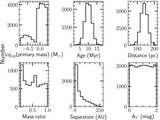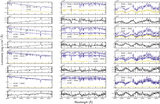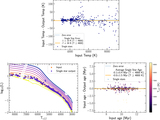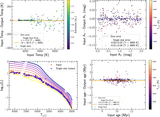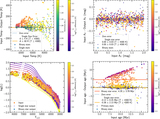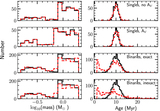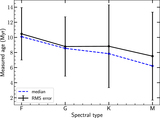Image Details

Caption: Figure 3.
An F2 (left), K4 (center), and M2 (right) primary star with secondary stars with mass ratios of 1, 0.9, 0.7, and 0.5 (from top to bottom). The spectral-type-to-temperature conversion was made using Pecaut & Mamajek (2013), and the temperature-to-mass conversion was made using the Dotter (2016) MIST models. The composite spectrum is shown in green, the primary in dark blue, and the secondary in gold. For a mass ratio of 1, the composite spectrum is identical to the stellar spectrum, but the luminosity is doubled. As the mass ratio decreases, the contribution of the secondary begins to have an effect on the spectral morphology, but at low mass ratios the effect of the secondary is not noticeable due to the large luminosity difference between the two components. If one of the components is not visible in the figure, it is because it is overlaid with another spectrum (e.g., in the top panel, the primary and secondary spectra are overlaid, so only the secondary is visible). The effect of multiplicity is more pronounced for later spectral types. Note the differing y-scales between panels.
Copyright and Terms & Conditions
© 2021. The American Astronomical Society. All rights reserved.



